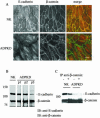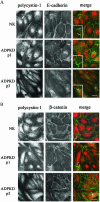A polycystin-1 multiprotein complex is disrupted in polycystic kidney disease cells
- PMID: 14718571
- PMCID: PMC363138
- DOI: 10.1091/mbc.e03-05-0296
A polycystin-1 multiprotein complex is disrupted in polycystic kidney disease cells
Abstract
Autosomal dominant polycystic kidney disease (ADPKD) is typified by the accumulation of fluid-filled cysts and abnormalities in renal epithelial cell function. The disease is principally caused by mutations in the gene encoding polycystin-1, a large basolateral plasma membrane protein expressed in kidney epithelial cells. Our studies reveal that, in normal kidney cells, polycystin-1 forms a complex with the adherens junction protein E-cadherin and its associated catenins, suggesting a role in cell adhesion or polarity. In primary cells from ADPKD patients, the polycystin-1/polycystin-2/E-cadherin/beta-catenin complex was disrupted and both polycystin-1 and E-cadherin were depleted from the plasma membrane as a result of the increased phosphorylation of polycystin-1. The loss of E-cadherin was compensated by the transcriptional upregulation of the normally mesenchymal N-cadherin. Increased cell surface N-cadherin in the disease cells in turn stabilized the continued plasma membrane localization of beta-catenin in the absence of E-cadherin. The results suggest that enhanced phosphorylation of polycystin-1 in ADPKD cells precipitates changes in its localization and its ability to form protein complexes that are critical for the stabilization of adherens junctions and the maintenance of a fully differentiated polarized renal epithelium.
Figures









Similar articles
-
Retention of membrane-localized beta-catenin in cells lacking functional polycystin-1 and tuberin.Mol Carcinog. 2002 Mar;33(3):131-6. doi: 10.1002/mc.10034. Mol Carcinog. 2002. PMID: 11870878
-
Modification of the composition of polycystin-1 multiprotein complexes by calcium and tyrosine phosphorylation.Biochim Biophys Acta. 2000 Dec 15;1535(1):21-35. doi: 10.1016/s0925-4439(00)00079-x. Biochim Biophys Acta. 2000. PMID: 11113628
-
Polycystin-1, the PKD1 gene product, is in a complex containing E-cadherin and the catenins.J Clin Invest. 1999 Nov;104(10):1459-68. doi: 10.1172/JCI5111. J Clin Invest. 1999. PMID: 10562308 Free PMC article.
-
Polycystin-1 interacts with E-cadherin and the catenins--clues to the pathogenesis of cyst formation in ADPKD?Nephrol Dial Transplant. 2000 Jan;15(1):1-2. doi: 10.1093/ndt/15.1.1. Nephrol Dial Transplant. 2000. PMID: 10607757 Review. No abstract available.
-
Apico-basal polarity in polycystic kidney disease epithelia.Biochim Biophys Acta. 2011 Oct;1812(10):1239-48. doi: 10.1016/j.bbadis.2011.05.008. Epub 2011 Jun 1. Biochim Biophys Acta. 2011. PMID: 21658447 Review.
Cited by
-
A pathogenic C terminus-truncated polycystin-2 mutant enhances receptor-activated Ca2+ entry via association with TRPC3 and TRPC7.J Biol Chem. 2009 Dec 4;284(49):34400-12. doi: 10.1074/jbc.M109.015149. Epub 2009 Oct 7. J Biol Chem. 2009. PMID: 19812035 Free PMC article.
-
Pathophysiology of childhood polycystic kidney diseases: new insights into disease-specific therapy.Pediatr Res. 2014 Jan;75(1-2):148-57. doi: 10.1038/pr.2013.191. Epub 2013 Oct 31. Pediatr Res. 2014. PMID: 24336431 Free PMC article. Review.
-
Molecular genetics and pathogenic mechanisms for the severe ciliopathies: insights into neurodevelopment and pathogenesis of neural tube defects.Mol Neurobiol. 2011 Feb;43(1):12-26. doi: 10.1007/s12035-010-8154-0. Epub 2010 Nov 27. Mol Neurobiol. 2011. PMID: 21110233 Review.
-
Polycystin and calcium signaling in cell death and survival.Cell Calcium. 2018 Jan;69:37-45. doi: 10.1016/j.ceca.2017.05.011. Epub 2017 May 24. Cell Calcium. 2018. PMID: 28601384 Free PMC article. Review.
-
Defining a link with autosomal-dominant polycystic kidney disease in mice with congenitally low expression of Pkd1.Am J Pathol. 2006 Jan;168(1):205-20. doi: 10.2353/ajpath.2006.050342. Am J Pathol. 2006. PMID: 16400024 Free PMC article.
References
-
- Angst, B.D., Marcozzi, C., and Magee, A.I. (2001). The cadherin superfamily: diversity in form and function. J. Cell Sci. 114, 629-641. - PubMed
-
- Arnaout, M.A. (2001). Molecular genetics and pathogenesis of autosomal dominant polycystic kidney disease. Annu. Rev. Med. 52, 93-123. - PubMed
-
- Arnould, T., Kim, E., Tsiokas, L., Jochimsen, F., Gruning, W., Chang, J.D., and Walz, G. (1998). The polycystic kidney disease 1 gene product mediates protein kinase C alpha-dependent and c-Jun N-terminal kinase-dependent activation of the transcription factor AP-1. J. Biol. Chem. 273, 6013-6018. - PubMed
-
- Balsamo, J., and Lilien, J. (1990). N-cadherin is stably associated with and is an acceptor for a cell surface N-acetylgalactosaminylphosphotransferase. J. Biol. Chem. 265, 2923-2928. - PubMed
-
- Barbar, E., Rola-Pleszczynski, M., Payet, M.D., and Dupuis, G. (2003). Protein kinase C inhibits the transplasma membrane influx of Ca2+ triggered by 4-aminopyridine in Jurkat T lymphocytes. Biochim. Biophys. Acta 1622, 89-98. - PubMed
Publication types
MeSH terms
Substances
Grants and funding
LinkOut - more resources
Full Text Sources
Other Literature Sources
Research Materials
Miscellaneous

